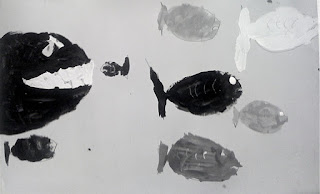Scale: big and little
What colors has he chosen?
Value chart? what is value?
How do we make colors lighter?
How do we make them darker?
Lines: what lines do we see, what lines can you think of?
Look at Matt Duffin's, Crowd Control, 2006 on display at Crocker Art Museum, Sacramento, CA
Does this painting remind you of a scene in the Wizard of Oz?
What is happening behind the curtain?
Why donkeys? are they smart?
What are they standing?
What is the artist trying to say?
ARTIST: Matt Duffin (1968-)
He grew up in Houston, Texas.
He received his Bachelor of Science in Architecture from the University of Houston.
He never practiced as an architect, choosing instead to become an artist. Through art, he found that he could easily combine his tendency toward right angles and persecutive drawing with the more human themes of solitude and irony.
Over time, his medium has evolved from charcoal to encaustic wax, but he continues to dwell in the realm of dark recesses and stark contrasts.
PRACTICE: on practice paper try drawing fish.
First reduce them down to two shapes: triangle, oval
Second: add details: fins, gils, scales, tail lines,
Now try drawing a very large fish almost the size of your paper
use the same techniques and details but make this fish have its mouth open
remember this is just practice drawing shapes, line and details.
Project: Big Mouth Fish
Step1: using a pencil draw a school of fish, at least 12, all the same on one half of your paper
Step2: On the other half draw a large fish mouth, from the side, big enough to eat the whole school.
Step3: using only black and white paint create 5 shades of grey
Step4: paint in your fish fight drawing using only grey paint.
Step5: using all your light shades of grey add in bubbles around the fish using different sized circles use straws, toothpicks, and bottle caps for the large fish.
Materials:
12x18 thick white paper
Tempura Black and white paint
Bowls or small cups to make new colors
straws


































